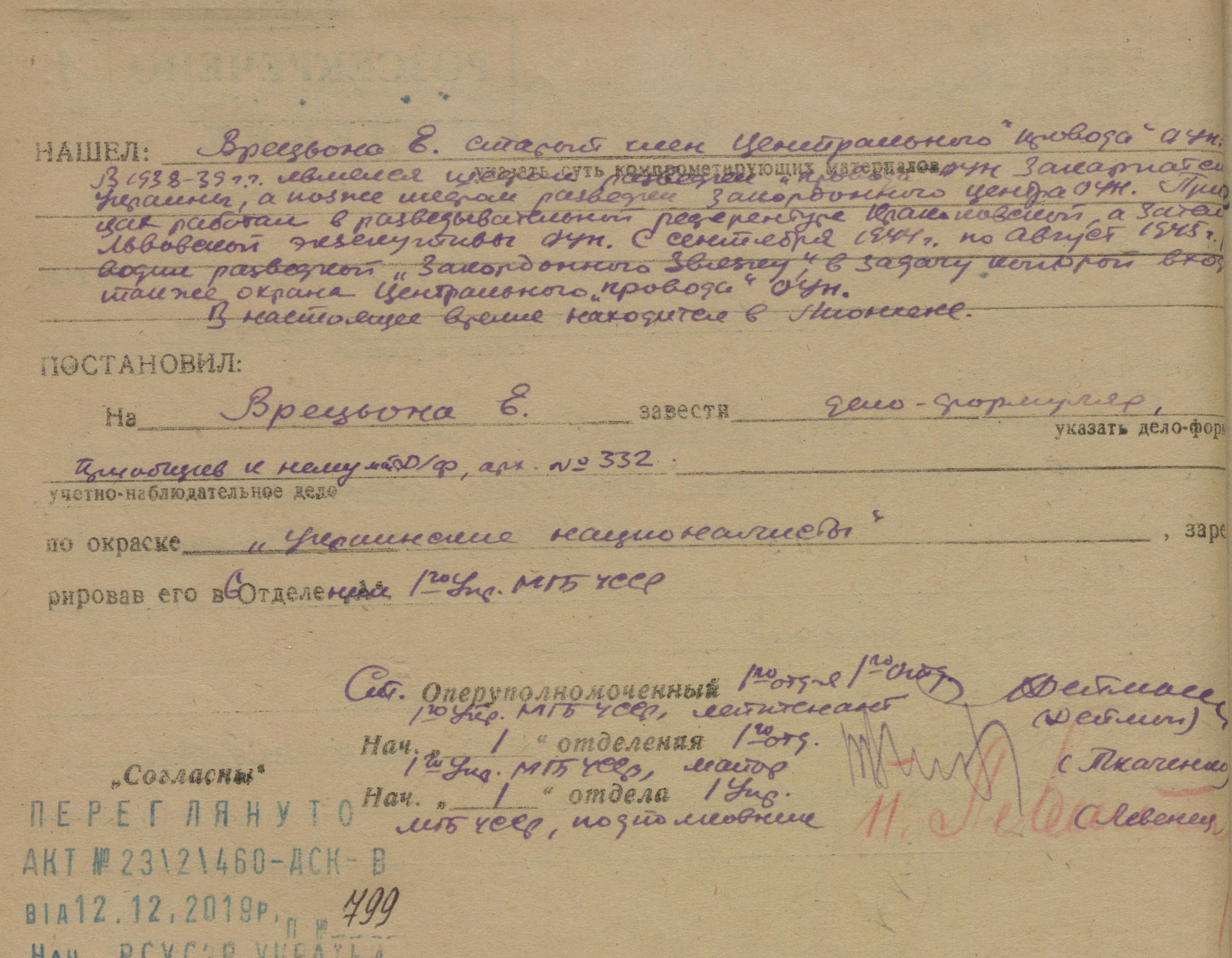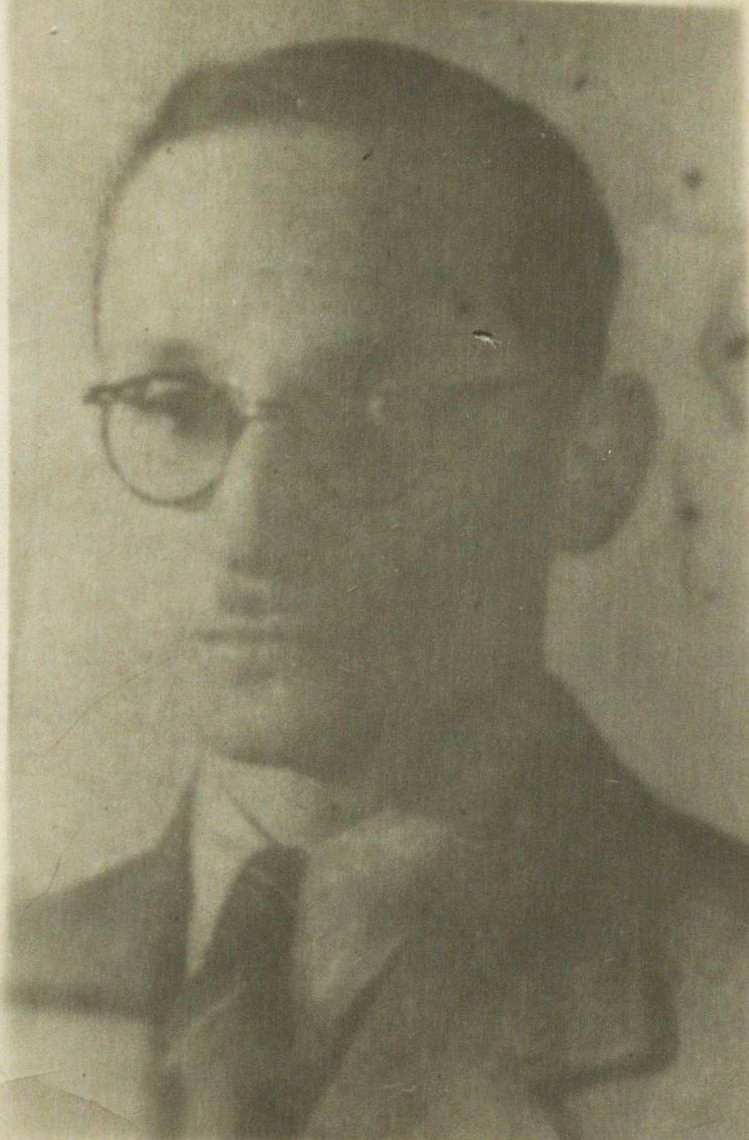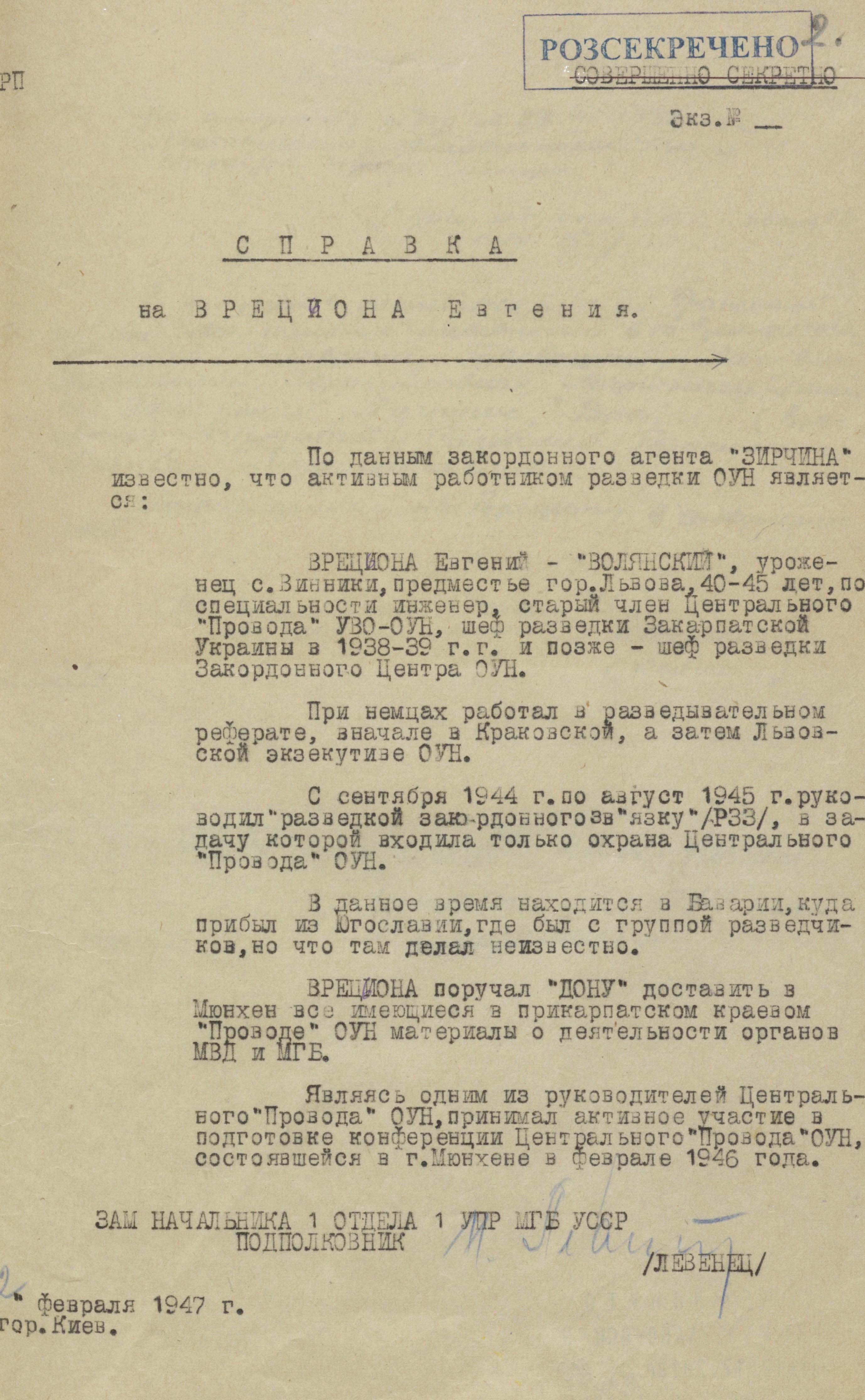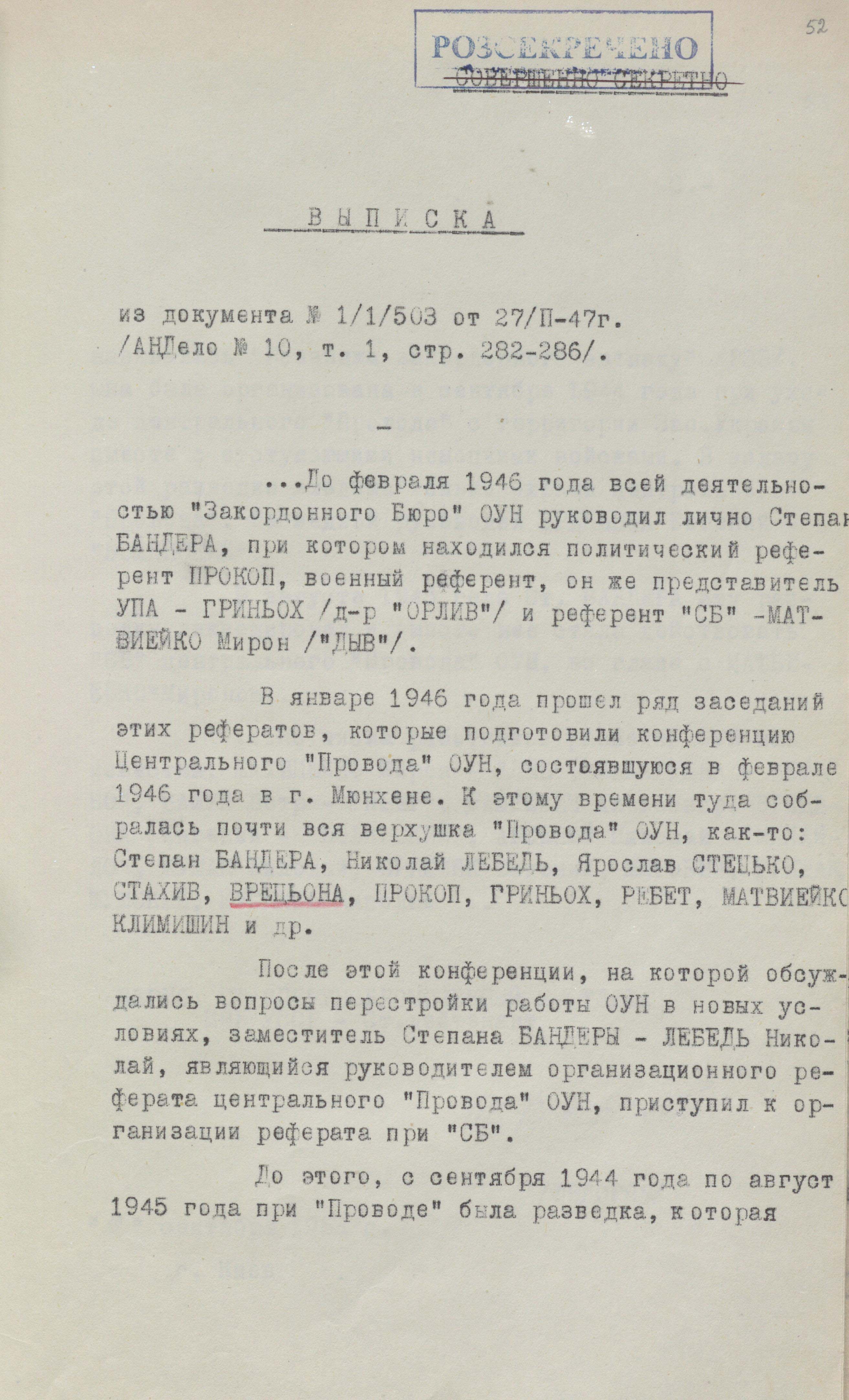Yevhen Vretsiona. The Chief of Intelligence of the OUN Foreign Center
2/9/2023
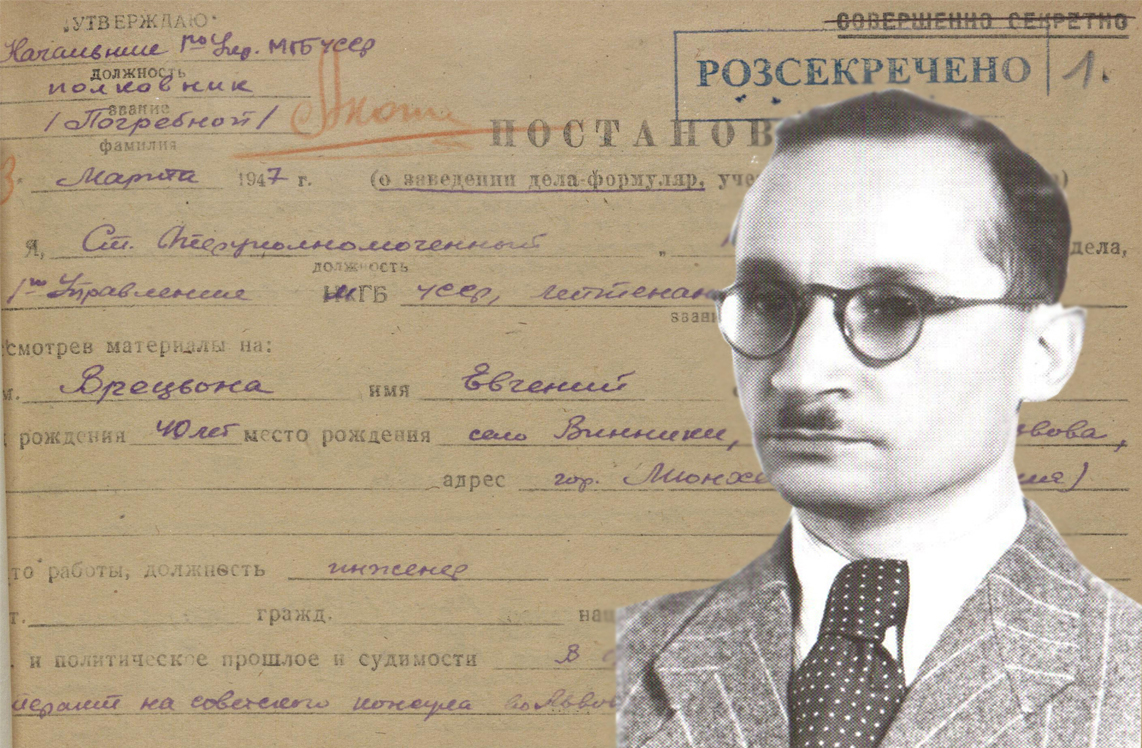
Among the foreign centers of Ukrainian political emigration, the most interesting for the Soviet special services were the formations of OUN, and in them – leading figures and ideologues, as well as senior staff of the Security Service (SB), which combined the functions of intelligence and counterintelligence and often prevented the Kremlin agents’ penetration into the ranks of émigré organizations. All the leaders of the Security Service of OUN were taken into active operational development as particularly dangerous enemies of the Soviet government. One of those was Yevhen Vretsiona, who in the declassified archival documents of the Foreign Intelligence Service of Ukraine is mentioned as the chief of intelligence of the “OUN Foreign Center” with the underground pseudonym “Volianskyi”.
On the cover of the case file, instituted in March 1947 by the First Department of the MGB of the Ukrainian SSR, the words “Case File” were crossed out and instead they wrote in hand: “Case of Cultivation”. This meant not just a usual accumulation of materials, but a purposeful study of the defendant in the case through foreign sources, operational and technical measures, agents’ infiltration into his environment in order to obtain information about his activities, to influence him and, under favorable conditions, even to make him change sides.
As a result of studying the operational cases of the NKVD in the 1930s, MGB officers formed a general idea of Yevhen Vretsiona as a person who from his youth was brought up on Ukrainian national traditions and was an irreconcilable fighter for freedom and independence of Ukraine from Moscow's enslavement. Various papers show that he was born in the village of Vynnyky, a suburb of Lviv, was a member of Plast and of the Ukrainian Military Organization (UMD), later – of OUN, had a higher education, was a chemical engineer, had a good command of German, French, Italian, English, Hungarian. In 1930, he led the underground in Lviv (official sources mention that at that time he was the Chief of the Military-Training Referentura of the Regional Executive of OUN).
At the same time, as mentioned in one of the papers, in response to the trial in the case of the Union for the Liberation of Ukraine, fabricated by the GPU of the Ukrainian SSR against the Ukrainian intelligentsia, he participated in an act of revenge – preparation of an attack on the Soviet consulate in Lviv. In this and other cases, he was repeatedly arrested by the Polish police. In 1933–1934 he immigrated to Czechoslovakia, where he was also “'engaged in active nationalist work”.
Archival documents fragmentarily mention that in 1938-1939 Ye. Vretsiona headed the intelligence of Carpatho-Ukraine, where he went to help in the liberation struggle. Other sources say that he was one of the organizers of military units (Carpathian Sich) in Carpatho-Ukraine, a member of the General Staff of the Carpathian Sich and the Chief of the Intelligence Department. It was then that he was granted the rank of Chotar.
On March 15, 1939, at the call of the Chief Command of the newly created Armed Forces of independent Carpatho-Ukraine, he volunteered for the Staff of its National Defense. And after the occupation of that territory by Hungarian troops, he was captured. Soon he fled to Romania, from there – to Austria.
When at the beginning of the Second World War the Western Ukrainian lands after the partition of Poland were ceded to the USSR, repressions against the Ukrainian nationalist movement began there. Therefore, active OUN leaders moved to Krakow and began to prepare an anti-Soviet uprising. Ye. Vretsiona was one of them.
“In 1940, Vretsiona moved to Krakow”, – reads the paper from the MGB of the Ukrainian SSR, – where he was the Chief of the Security Service of the main Provid (Leadership- Transl.) of OUN, at the same time teaching intelligence on the course for OUN officers”.
Organizationally, intelligence was built on the classical scheme – according to object and territorial principles. Structurally, in particular, the intelligence referentura of the Krakow Center of OUN(B) consisted of a department of political intelligence (studied Soviet administrative, party and Komsomol bodies, other legitimate institutions, moods of the population, identified activists among the local population) and a military intelligence department (collected information about the Red Army, NKVD and law enforcement agencies).
District provids in Lviv, Stanislav, Drohobych, Ternopil, Lutsk and other cities were subordinated to the Centre. Gradually, the intelligence network spread even to the central and eastern regions of Soviet Ukraine. Regional provids consisted of 3-5 sub-regional provids, sub-regional provids consisted of 3 -5 district provids, which, in turn, were divided into sub-district ones. The provid had to include an intelligence referent. Each settlement was supposed to have an intelligence officer.
The agent apparatus consisted of residents, agents (informants), liaisons. Intelligence work relied on a fairly extensive network of informants. When selecting informants, preference was given to persons who lived legally and had intelligence capabilities. The basis of cooperation was ideological and patriotic, at the same time they were often recruited on the basis of addiction, intimidation, blackmail. Usual practice was written enshrining of recruitment.
As a rule, intelligence referenturas of territorial provids were in touch with 5-20 residents from the most trained underground workers who recruited informants, summarized information and passed it over by conspiratorial communication lines vertically. The intelligence collected in the region was summarized by analysts and transferred to the Krakow Center.
In this case file, there is no information about specific operations of the intelligence referentura of the Krakow Center of OUN(B), nor about Ye. Vretsiona's participation in them. Quite fragmentarily, archival documents reflect the period of the German-Soviet war. It is reported that Ye. Vretsiona within the very first days of the war arrived in Lviv, “lived at 14, Yatskiv Street, had own trading enterprises and continued to work actively in the OUN underground”.
The fact that he was directly involved in the creation of UPA is not mentioned. Although in reality his participation in this process was noticeable. Instead, it is reported that as a member of the OUN external relations referentura, in 1943-1944 he was engaged in establishing contacts with abroad. This referentura was engaged in intelligence. And from “September 1944 to August 1945, he managed the External Relations Referentura, a structure whose duties included protection of the Central Provid of OUN”. “In August 1945, S. Bandera liquidated this intelligence”, – reads another document, – “and instead of it, the Security Service of the Central Provid of OUN, headed by Myron Matviyeyko, began to operate”.
At that time, Ye. Vretsiona was elected a member of the Ukrainian Supreme Liberation Council – the underground Parliament and Government of Ukraine, and by its decision in 1945, he was sent to Italy to establish contacts with Anglo-American allies. He was a member of the Foreign Representation of the Ukrainian Supreme Liberation Council, and in 1948–1950 he served as President of this body after Mykola Lebid.
It was then that the MGB began his active cultivation. “According to agent “Fourth”’s report dated December 18, 1951”, – one of the documents states, – “Vretsiona is Lebid's deputy in Switzerland, chief of the intelligence of the Ukrainian Supreme Liberation Council... He lives permanently in Switzerland, but sometimes visits Munich (Western Germany), where at 9, Karlsplatz, in the editorial office of “Suchasna Ukraina” has a separate room”.
Archival documents repeatedly mention that E. Vretsiona was published a lot in the newspapers “Ukrainska Trybuna”, “Suchasna Ukraina”, “Suchasnist” and others. But still the main attention was focused on his intelligence work. For example, one of the reports points out that according to intelligence information, it is known that Ye. Vretsiona “lately has been staying in Bavaria, where he arrived from Yugoslavia, where he had been with a group of intelligence officers, but what he had been doing there is unknown. Vretsiona instructed “Don” to bring to Munich all the materials available in the Carpathian regional provid of OUN about the activities of the MVD and MGB.
At that time, the leadership of the USSR demanded from its state security bodies more decisive measures to counter foreign centers of Ukrainian emigration. The most common way of infiltrating these centers was based on the infiltration of their agents into them, recruiting emissaries who came from abroad to Soviet territory and fell into the hands of the MGB. In some cases, Soviet intelligence tried, with the help of such recruited emissaries, to start operational games with foreign centers of OUN. Therefore, Ye. Vretsiona, realizing this, in his work paid great attention precisely to preventing the infiltration of agents of Soviet special services into the ranks of the OUN.
Characteristic of this is the report of the SB (Sluzhba Bezpeky – Security Service- Transl.) OUN referent with pseudonym “Usmikh” (“Smile”- Transl.), dated February 1950 with the resolution “To the case on Vretsiona”. Among other things, it tells about the MGB’s tactics abroad. According to the SB referent, its main methods were as follows:
“Transfer of agents recruited from former members of OUN and UPA; infiltration of its agents into our ranks; destroying organizations and institutions and creating oppositions and organizations obedient to the MGB; mass infiltration of agents into other Ukrainian organizations and attacks on the liberation movement from there; mass transfer of agents from territory to territory; provocations and compromises; denunciations to the authorities and the authorities’ attacks on the liberation movement; paralyzing the ties with allies; organization of discord between Westerners and Easterners; declaring our people agents of the MGB for the purpose of provocation; incitement of ideological and programmatic hostility; acquisition of the press and literature; fighting us with the help of intelligence satellites, Russian and Polish right-wing groups; creating enmity between OUN and UPA”.
The fact that this report was intercepted and decrypted by the MGB shows that the confrontation at that time was very difficult, and Yevhen Vretsiona had to make great efforts on this secret front. In addition, the MGB took into cultivation all his close relatives, trying to find among them those who could be sent abroad to influence the main defendant in the case in the right direction. Even the option of the possibility of recruiting Ye. Vretsiona in the future was considered. But this idea remained only on paper. No grounds or clue could be found for this. Eventually, in 1966, the cultivation was stopped and the case was transferred to the archive due to the lack of operational capabilities to work on it.
At the same time, this case is another confirmation that Ukrainian emigres abroad never stopped the struggle for the restoration of Ukraine's independence. For this purpose, they had organizational structures, which constantly included intelligence and counterintelligence units, headed by persons committed to the national idea. They, of course, were hunted by Soviet special services at the behest of Moscow. And this struggle and confrontation persisted almost until the collapse of the USSR.

